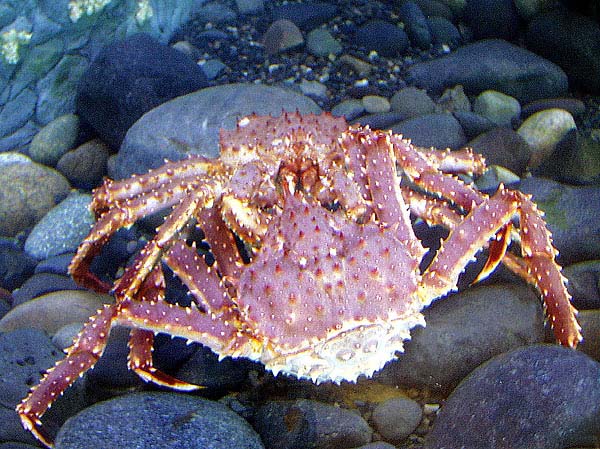
No higher resolution available.

|
This image was uploaded to the shared "Image Pool" and is usable on any CreationWiki site.
Please go to the Pool to edit its description.
|
Summary
This "grasping pair" of male and female red king crab, Paralithodes camtschaticus, were collected in the shallow waters of Womens Bay, Kodiak Island. They migrate to shallow water to mate or "grasp." The juveniles stay in shallow waters aggregating into huge balls of crab; in Womens Bay these congregations often cling to pilings under a pier. The pods disperse at night, reforming at dawn. Adults are large, males 227 mm by 283 mm, reddish brown to purple, covered with spines. They range from Barrow and the Chukchi Sea (MacGinitie, 1955), the Bering Sea to the Queen Charlotte Islands, and along the Aleutian Islands to Japan. They have been recently introduced to the Atlantic coast of Russia and Norway (Kuzmin et al., 1996). Adults prefer sand or mud bottoms, ranging from 3 to 366 m. Their diet consists of sea stars, urchins, clams, barnacles, and other benthic invertebrates. The largest crab in U.S. waters, the king crab are very important commercially; in U.S waters, they are presently taken primarily in the Bering Sea and in Southeast Alaska.
Scientific name: Greek para (beside, near, parallel) andlithodes (rock like); and Latin camtshaticus (belonging to Kamchatka).
Copyright status
This picture can be used because It was first published by NOAA
Source
http://www.afsc.noaa.gov/kodiak/photo/crabgprkc14a.htm
File history
Click on a date/time to view the file as it appeared at that time.
| Date/Time | Thumbnail | Dimensions | User | Comment |
|---|
| current | 03:44, 23 November 2007 |  | 600 × 449 (87 KB) | TSpeck11 | A pair of red king crabs mating in shallow waters. |
File usage
The following 2 pages use this file:
This file contains additional information, probably added from the digital camera or scanner used to create or digitize it.
If the file has been modified from its original state, some details may not fully reflect the modified file.

